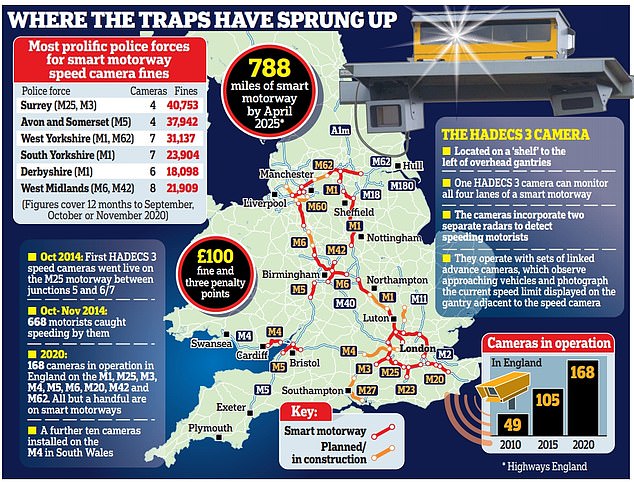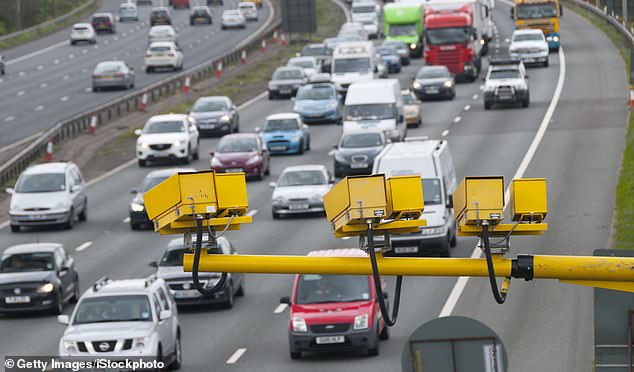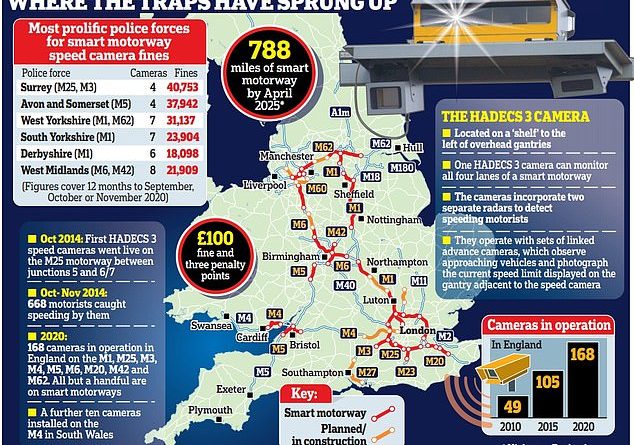'Stealth cameras' on smart motorways blamed for surge in speeding fines
The number of speed cameras on motorways has trebled in a decade – and they are now responsible for more than one in ten of all speeding fines issued by police.
The ‘stealth cameras’ have proliferated because they are deemed crucial to controversial smart motorways.
Figures obtained by the Mail showed that more than 253,000 notices of intended prosecution (NIPs) were issued in the 12 months to this autumn by 17 of the 20 police forces whose areas cover smart motorways in England and Wales.
The figures – which exclude fines issued by temporary, average speed check cameras – reveal for the first time the extent of speeding penalties issued on motorways.

The number of speed cameras on motorways has trebled in a decade – and they are now responsible for more than one in ten of all speeding fines issued by police
It comes after speeding fines hit a record 2.3million last year in England and Wales, driven by the growth of smart motorway cameras.
Smart motorways account for 416 miles of road and are expected to almost double in length by 2025, and so a huge number of extra cameras are due to be installed.
They are supposed to improve traffic flow by varying the speed limit, using the hard shoulder as a driving lane and asking drivers to stop in ‘refuges’ if their car breaks down.
But the scheme has faced controversy after a series of fatal accidents when cars have broken down in a live lane. Now campaigners say they are also behind an unfair surge in speeding fines.
Motoring organisations say the cameras are hard to see. They are small and typically are mounted on the left-hand side of gantries at the edge of the motorway. Sometimes they can be obscured by signs or vegetation.
To begin with, the cameras were painted grey. They did not have to be painted yellow – like traditional Gatso cameras – until 2017.
When first installed in 2014, the cameras, of a model known as HADECS3 (Highways Agency Digital Enforcement Camera System), were nicknamed ‘stealth cameras’. There were only 49 motorway speed cameras in England in 2010, but there are now 168 in operation on the M1, M25, M3, M4, M5, M6, M20, M42 and M62. All but a handful are on smart motorways.
A further ten cameras have been installed on the M4 in South Wales. Scotland has only started to install cameras on motorways so no statistics are available.
Separate figures show that two cameras on a traditional stretch of motorway on the M4, operated by the Metropolitan Police, snapped a further 37,295 motorists in the first ten months of last year – equivalent to more than 120 per day.
Last night motoring groups expressed concern about the way they are being used.
Edmund King, AA president, said: ‘The majority of drivers support the use of cameras if used for safety reasons, but there are inconsistencies in their use which can catch drivers out.’
While smart motorways display signs warning motorists that cameras are being used, Mr King also called for better signage to show exactly where they are located.
‘Signs should be displayed on all gantries when cameras are in place as the objective should be to slow people down, not catch them out,’ he said.

The ‘stealth cameras’ have proliferated because they are deemed crucial to controversial smart motorways

Figures obtained by the Mail showed that more than 253,000 notices of intended prosecution (NIPs) were issued in the
12 months to this autumn by 17 of the 20 police forces whose areas cover smart motorways in England and Wales
Motoring groups are also concerned about how the cameras are used.
Some police forces only switch them on when reduced speed limits are in operation, while others use them at all times including when the standard 70mph limit applies.
But Highways England, the government department responsible for major roads, insists speed cameras are necessary on smart motorways to enforce reduced speed limits when lanes are closed due to congestion, breakdowns, collisions or roadworks. It said drivers are made aware of them by frequent signs on gantries.
Jeremy Phillips, head of road safety at Highways England, said: ‘We’re not using cameras to catch drivers out or to make money out of fines.
‘They’re there to encourage drivers to stick to speed limits, for the safety of everyone using the road, and to help traffic flow freely.
‘That’s why they are bright yellow and clearly-signed; alerting drivers to the presence of cameras helps to encourage compliance and so improves safety.’
Highways England added that it encourages road users to report any vegetation or other obstructions hiding cameras from view.

